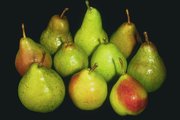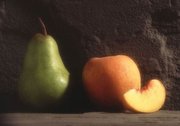Pear
|
|
- PEAR is also the acronym of the PHP Extension and Application Repository
| Pear | ||||||||||||||
|---|---|---|---|---|---|---|---|---|---|---|---|---|---|---|
 European Pear branch with fruit | ||||||||||||||
| Scientific classification | ||||||||||||||
| ||||||||||||||
| Species | ||||||||||||||
|
About 30 species, including: |
Pears are trees of the genus Pyrus and the fruit of that tree, edible in some species. Pears are native to temperate regions of the Old World, from western Europe and north Africa east right across Asia. They are medium sized trees, reaching 10-17 m tall, often with a tall, narrow crown; a few species are shrubby. The leaves are alternately arranged, simple, 2-12 cm long, glossy green on some species, densely silvery-hairy in some others; leaf shape varies from broad oval to narrow lanceolate. Most pears are deciduous, but one or two species in southeast Asia are evergreen.
Nashipear_pair.jpg
The flowers are white, rarely tinted yellow or pink, 2-4 cm diameter, and have five petals. Like that of the related apple, the pear fruit is a pome, in most wild species 1-4 cm diameter, but in some cultivated forms up to 18 cm long and 8 cm broad; the shape varies from globular in most species, to the classic 'pear-shape' of the European Pear with an elongated basal portion and a bulbous end.
There are about 30 species of pears. Three are important for edible fruit production, the European Pear Pyrus communis cultivated mainly in Europe and North America, the Ya Pear Pyrus bretschneideri, and the Nashi Pear Pyrus pyrifolia (also known as Asian Pear or Apple Pear), both grown mainly in eastern Asia. There are thousands of cultivars of these three species.
Bradford_9288.JPG
Other species are used as rootstocks for European and Asian pears and as ornamental trees. The Siberian Pear, Pyrus ussuriensis (which produces unpalatable fruit) has been crossed with Pyrus communis to breed hardier pear varieties. The Bradford Pear (Pyrus calleryana 'Bradford') in particular has become widespread in North America and is used only for decoration. The Willow-leafed Pear (Pyrus salicifolia) is grown for its attractive slender, densely silvery-hairy leaves.
Pears are consumed fresh, canned, and as juice. Fermented pear juice is called perry. The place name Perry can indicate the historical presence of pear trees.
Pear wood is one of the preferred materials in the manufacture of high-quality woodwind instruments.
See also
External links
- usa pears (http://www.usapears.com/pears/varieties.asp) - descriptions of pear cultivars from a U.S. advocacy group.
- Pear nutrition information (http://www.kallipolis.com/diet/food.php?id=9252&w=3)
- Cooking for engineers - kitchen notes on pears (http://www.cookingforengineers.com/article.php?id=96)
Template:Wiktionary Template:Commonscy:Gellygen da:Pære (Pyrus) de:Birnen eo:Piro fr:Poire he:אגס it:Specie di Pyrus nl:Peer (vrucht) ja:ナシ pt:Pêra (fruta) fi:Päärynä sl:Hruka sv:Päron wa:Poere zh:梨


